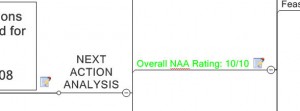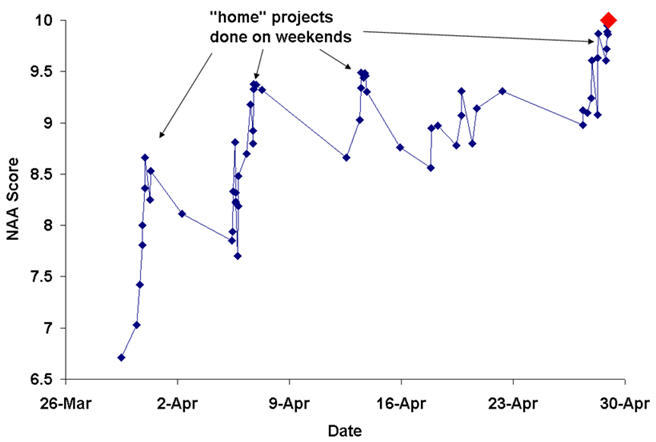Six Components of a GTD Review
Things have gotten a bit quiet in “gyrospace” lately. Perhaps this is because folks have given up on their new year’s resolutions or moved on to other tools. I’m hoping it is because we are all successfully focusing on Getting Things Done rather than tinkering with our systems and surfing blogs.
After three years of exploring and tinkering (I bought ResultsManager in May 2005) and collaborating with many of you, I feel I’ve finally developed a balanced “trusted system” approach that works for me utilizing OutLinker, MindReader, Next Action Analysis, and Mark Task Complete. These macros have finally allowed me to fully leverage the MindManager, ResultsManager, and GyroQ applications.

The Next Action Analysis approach has been pivotal in proving a look at things in a more balanced and comprehensive way. The “game” of trying to empty Outlook inboxes and raise my NAA score has provided just enough incentive to get me to plug my GTD leaks and attack those lingering “high cringe factor” items clogging up my dashboard.
Previously I would spend all my dashboard and review time at the top of the Daily Action Plus Dashboard trying to empty in-trays and deal with items past their deadlines or targets, and neglecting other aspects. Now I feel like my focus shifts appropriately to the 5F that needs the most attention.
After using this set of tools for four months, this week I finally hit a perfect 10.0 on my personal maps and also got my work maps up over 9. If only I had got here during the contest :-).

A trend of my score over time is included at the bottom of the post based on the data collected in the NAALog.mmap. I tend to work with my personal maps on the weekend while doing chores and errands and paying bills :-(. Along the way I spent a lot of time fighting back the tide on each of the 5F’s in turn. Once the macro gave me my “perfect score”, the question became “what is the next action”?
To celebrate I took a break this evening to create the diagram above, which captures the NAA framework concisely and graphically. This may be helpful to you whatever GTD system or tools you actually use. What makes the next action analysis macro useful is that it generates quantitative metrics for these components and links out to the items that impact each of them (e.g. overdue or aging tasks) rather than requiring separate dashboards for these purposes.
The figure adds a 6th component to the five covered by the NAA tool, which is asking whether you are capturing the “Full Picture” of your work. You can’t automate that, although GyroQ can be used to run a full “MindSweep”. The other aspect captured in this component is the need for a regular review of “someday/maybe” lists to see what deferred projects merit activating. You might implement this by using a weekly repeating task reminder and then ensure that it stays fresh!
Of course for me what really remains now is finally giving more attention to “non squeaky wheel” projects and actions not currently in the penalty box. I won’t be at 10.0 for long if I don’t attack the 60 next actions on my home list and 80 on my work list. Unfortunately blogging isn’t on either of them :-).
All the best,
AO









 Entries
Entries 
Jose Miguel Bolivar said,
May 1, 2008 @ 3:55 pm
Wow! 10.0 is a terrific score.
I have managed to stay over 9.0 on my personal maps since the contest but I think I have never gone over 9.90.
On my work maps I am normally between 8.0 and 9.0, mainly because of many overdue “waiting for” :-)
Anyway I keep using MindReader, MarkTaskComplete and Next Action Analysis on a daily basis and they are the backbone of my “trusted system”, which so far works great.
I would reconsider to add “blogging” back to your Next Action List. We miss your post :-)
JM
ActivityOwner said,
May 1, 2008 @ 8:02 pm
It is easy to score 10.0 when you are the one controlling the scoring rules :-). My main challenge has been facing up to several “aging tasks” and it felt great to knock them off. You know you are in trouble when “empty desk in-tray” makes it onto the “oldest actions” list!
I think once we are up in the 9+ range, we need to find ways to get NAA to drive basic context list driven work. To be honest, with the exception of errands and “relationship” lists, I continue to work entirely from the NAA side of the dashboard.
Note that I made one recent tweak in adding a small penalty for having an excessive amount of “waiting for” tasks. I had accumulated >170 “waiting fors” at work and felt there needed to be some pressure to clean them up. What do you think is a reasonable “10.0” level of waiting items?
At home I think ~20 is probably realistic, but at work you might easily have 100+ active “waiting” items if you manage large groups. Perhaps the penalty should only be on items without explicit target dates?
I’ll try to get back to some more posting. I actually moved all my AO stuff to “R:AO” to facilitate my 5.0->10.0 journey. Blog maps tend to gather a lot more “write this”/”read-this”/”someday/maybe” stuff than other areas of life.
Jose Miguel Bolivar said,
May 2, 2008 @ 5:57 pm
I think adding a penalty on items without explicit target dates is a better approach than just on the number. As you well said, it might be that having 100+ “waiting” items were something “normal” to some extent.
Anyway, setting an additional quantitative limit of 120-150 “waiting” items would also be an idea to consider.
ActivityOwner said,
May 3, 2008 @ 6:59 am
I changed it to not count “waiting-for” tasks that have a due date on themselves or their parent project and to allow for 15 items with no target date for now.
A total limit seems like a good idea but we’d need to decide what area and weighting to assign to it. That seems like a good metric to put in the “focus” category, perhaps at the expense of some of the 0.1 weighting on “number of projects”.
Having 150+ “waiting for” may mean you are micromanaging that should be handled by a 2nd layer of management or that you are not focusing/sequencing your teams work sufficiently.
I’m finding just trying to put a target date on items helps to clarify the priority and “committed” status of items and is eliminating quite a few of them.
BillS said,
May 3, 2008 @ 11:35 am
I recently took a class at work “Lean Fundamentals of Transactional Environment” which, among other things attempts: to reduce # number of touch points, eliminate unnecessary non-value added actions/processes, increase efficiency through 5S (www.epa.gov/lean/thinking/fives.htm). At the moment, the last item I think could be a metric around how deep your topics & subtopics are in projects & subprojects. This could be an indicator on whether you’re really providing enough detail & whether you’re organizing your actions around projects & subprojects. So, penalties for actions w/ no project/subproject or > 10(?) actions in project should be considered a subproject.
Thoughts?
ActivityOwner said,
May 3, 2008 @ 12:00 pm
Thanks Bill — I think “lean thinking” is a interesting area that has a lot of GTD parallels we should explore.
I’ve tried to capture some of what you are referring to by having metrics on “focus” which encourage target dates for projects and keeping the number of projects managable. That tends to force things into projects rather than “areas of focus”. I find quite a bit of my tasks are completed before they get out of the in-tray, which is fine with me. I set the in-tray’s on my area map centrals to “projects”, which perhaps is “cheating”, but it has been working.
The naa tool works solely on the vanilla daily action dashboard so it is limited in what it can extract about topic location in the project structure.
I like the idea of checking for an excessive number of personal next actions in a given project. That usually is a sign of a need for sequencing. The report currently points you to the project and map in which you have the most actions but doesn’t do any scoring based on that.
BillS said,
May 4, 2008 @ 10:24 am
AO,
I agree that there are some interesting parallels we should explore. Obviously, the point is NOT to overwhelm organizing/standardizing but do what makes sense for action items. Another idea, though probably CPU intensive, would be to provide a metric on what “stuff” is lying around in maps. If the “stuff” is not an action item and it is not in the correct “reference” map/topic (other ideas?) a penalty is assigned. Maybe even checking to make sure a hyperlink/attached file is in the sub-directory of the project map. I think this could help get the reference material filed properly. I’ve 2 approaches lately toward finding ref. material: Throw everything in My Documents & let Windows Desktop Search (or Goggle if you prefer), or neatly categorize everything into a strict taxonomy folder structure. Both have pros/cons but I think a hybrid approach would work best. While many projects are short-lived the material generated during that project tends to have value on new projects. And this reference material should be made instantly available.
Jim said,
May 5, 2008 @ 7:52 pm
I’ve been quiet as of late as I’ve been trying out the Mac side of GTD apps (Things is my favorite of the whole bunch), but this chart and the completeness of what you’re writing about is making me think I’ve been missing quite a bit for the sake of beauty.
Please keep letting us know about your process and what you’ve been doing to keep up with it – fascinating stuff. Thanks!
ActivityOwner said,
July 7, 2009 @ 6:48 am
I uploaded a new version of the code that eliminates an odd bug one user was experiencing where the macro failed halfway through. This version also uses updated “scoring” curves that improve the incentives.